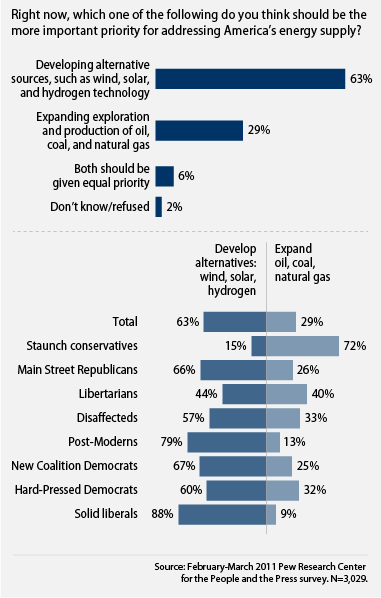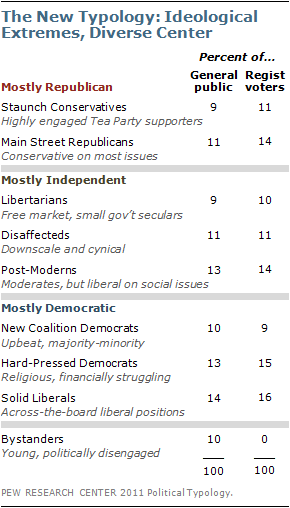Anyone with a box of Crayolas and a 1-year-old, and anyone who’s been following climate politics in the United States would tell you that, contrary to the rules of color theory, red and blue make an ugly mud color. But new research from Pew suggests that red and blue actually come out green—bright green, in fact, when it comes to “red-” and “blue-state of mind” support for alternative energy!
All that is to say that Americans almost all the way across the political spectrum support clean energy development over expanding fossil fuels. Center for American Progress public opinion expert Ruy Teixeira sums it up. Get this:
Overall, the public prioritizes developing alternative energy over expanding oil, coal, and natural gas by a 63-29 margin. And, as shown in the chart below, seven of Pew’s eight active typology groups support this position, including a whopping 40-point margin among the Main Street Republican group. Only the staunch conservatives (9 percent of the public) dissent from the rest.
And here’s CAP’s visual.

Courtesy Center for American Progress.
Green doesn’t negate red or blue, however. Attitudes about alternative energy obviously don’t necessarily match up with support for other environmental policies. But there are some interesting twists when it comes to perceptions about environmental policies’ impact on the economy and jobs.
Attitudes about the environment divide the two core GOP groups: 92% of Staunch Conservatives say that stricter environmental laws cost too many jobs and hurt the economy; just 22% of Main Street Republicans agree.
And…
Opinions about business, immigration and the economic impact of environmental laws and regulations also divide the Democratic groups. For instance, more than half of Hard-Pressed Democrats (54%) say that stricter environmental laws and regulations cost too many jobs and hurt the economy; just 22% of New Coalition Democrats and 7% of Solid Liberals share this view.
The Pew report, “Beyond Red vs. Blue: The Political Typology” is worth a read (it also explains the categories listed above—and the table below does too). Beyond this gem about alternative energy, the gist is that a growing number of Americans are choosing not to identify with either political party, and the center of the political spectrum is increasingly diverse and hard to pin down. The squishy middle is a misnomer—middle doesn’t mean moderate!
Rather than being moderate, many of these independents hold extremely strong ideological positions on issues such as the role of government, immigration, the environment and social issues. But they combine these views in ways that defy liberal or conservative orthodoxy.
The upshot is that party leaders, both red and blue—and I suppose other policy champions and advocates—will have a tougher and tougher time not only appealing to ideological and moderate “wings” within their coalitions, but also “holding together remarkably disparate groups, many of whom have strong disagreements with core principles that have defined each party’s political character in recent years.”
Here’s a snapshot of the typologies that Pew identifies—and their mindsets:
There’s lots more juicy stuff in there for anyone interested in shifting political attitudes and impacts on electoral politics. I won’t go into all of it here. But I’ll leave you with two more tidbits I found particularly interesting:
- More than in the recent past, attitudes about government separate Democrats from Republicans, and it is these beliefs that are most correlated with political preferences looking ahead to 2012.
- Majorities in most typology groups say the country will need both to cut spending and raise taxes to reduce the budget deficit. Staunch Conservatives are the exception—59% say the focus should only be on cutting spending.

